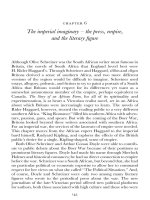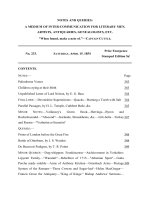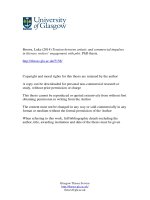marxism and marxist literary criticism
Bạn đang xem bản rút gọn của tài liệu. Xem và tải ngay bản đầy đủ của tài liệu tại đây (1.7 MB, 39 trang )
Marxism and Marxist
Literary Criticism
A Lens of Social Class & Social Power
Journal:
What do you consider to be a social
class? How do you define it? What is it
based on? What do you think leads
people to become members of a particular
social class? Can a person change his or
her social class? If so, how? Is one social
class more powerful or weaker than
another? Explain your responses in a
complete paragraph.
Introduction
Any political practice or theory based on
an interpretation of the works of Karl Marx
and Friedrich Engels
Including Communist Parties and
Communist states
Marxism
Along with psychoanalytical, feminist, and
cultural criticism, Marxist literary criticism
exemplifies what the French philosopher Paul
Ricouer terms a “hermeneutics of suspicion.”
These are approaches that concern themselves
not with what the text says but what it hides.
As Terry Eagleton, a leading Marxist critic,
writes, the task of Marxist literary criticism “is to
show the text as it cannot know itself, to
manifest those conditions of its making
(inscribed in its very letter) about which it is
necessarily silent.”
Marxism
The Marxist approach to
literature is based on the
philosophy of Karl Marx, a
German philosopher and
economist. His major
argument was that whoever
controlled the means of
production (the factories) in
a society controlled the
society.
Marx noted a disparity in the
economic and political power
enjoyed by the factory
owners and not allowed to
the factory laborers.
Marxism
He believed that the means
of production (i.e., the
basis of power in society)
should be placed in the
hands of those who
actually operated them. He
wrote that economic and
political revolutions around
the world would eventually
place power in the hands of
the masses, the laborers.
Reading from a Marxist Perspective
To read a work from a Marxist
perspective, one must understand
that Marxism asserts that literature
is a reflection of culture, and that
culture can be influenced by
literature.
Marxists believe literature can
instigate revolution.
4 Main Areas of Study
1.
2.
3.
4.
Economic Power
Materialism vs. Spirituality
Class Conflict
Art, Literature, & Ideologies
Economic Power
A society is shaped by its forces of
production. Those who own the means of
production dictate what type of society it
is.
The two main classes of society are:
1. the bourgeoisie (who control the means
of production and wealth) and
2. the proletariat (who operate the means of
production and are controlled by the
bourgeoisie).
Economic Power
Since the bourgeoisie own the means of
production—and, therefore, control the
money— they can manipulate politics,
government, education, art, and media.
Capitalism is flawed in that it creates
commodification (a desire for possessions,
not for their innate usefulness, but for
their social value). Display of material
objects is the most common way of
showing off one’s wealth.
Economic Power
Commodification is one way the
bourgeoisie keep the proletariat
oppressed. Whenever the proletariat
manages to acquire some sort of
status symbol, the bourgeoisie
concocts a new one; thus, the
proletariat continues to struggle,
never able to “catch up.”
Materialism vs. Spirituality
Regardless of what some might claim, social
values reflect material goals, not abstract
ideals.
The material world is the only non-subjective
element in a society. Money and material
possessions are the same by every measure
within a society, whereas spirituality is
completely subjective.
The quality of a person’s life is not destroyed
by spiritual failure but by material failure.
Class Conflict
A Capitalist society will inevitably
experience conflict between its social
classes.
The owners and the workers will have
different ideas about the division of the
wealth generated, and the owners will
ultimately make the decision.
This constant conflict, or dialectical
materialism, is what instigates change.
Class Conflict
Marx called on the proletariat to reject the social
structure of the bourgeoisie, the rules that would
keep them subservient forever, and form their
own values. Such a course would be the only way
to escape the oppression, for the proletariat
could never defeat the bourgeoisie on its own
terms. For the workers to win, they must
establish new terms.
Class Conflict
The bourgeoisie present their political, economic,
and social structures as the only reasonable ones.
The proletariat, indoctrinated from birth to have
pride in their station, are prevented from
wanting to overthrow their oppressors
(ironically, the smaller and actually less-powerful
group).
The only real social division is class. Divisions of
race, ethnicity, gender, and religion are artificial,
devised by the bourgeoisie to distract the
proletariat from realizing their unity and
rebelling against their oppressors.
Art, Literature, & Ideologies
• Art and literature are among the vehicles by
which the bourgeoisie impose their value system
on the proletariat. The arts can make the current
system seem attractive and logical, thus lulling
the workers into an acceptance of it.
• Works of art and literature are enjoyable, so the
audience is unaware of being manipulated.
Art, Literature, & Ideologies
• The bourgeoisie control most artistic output
because, whether through patronage or
sponsorship, they are the entity that funds the
arts and entertainment. Since the bourgeoisie
materially support the writers and the painters—
owning the means of production as well as
serving as primary consumers—the artist must
be careful not to offend bourgeois values.
Anything offensive or challenging to the
bourgeoisie will simply not be published or sold.
• Any artist who wishes to criticize the bourgeoisie
must do so in a subtle way (satire, irony, etc.).
Characteristics of Marxism
Attention to the material conditions of
people's lives, and lived relations among
people
People’s consciousness of the conditions
of their lives reflects these material
conditions and relations
“Social class" = differing relations to
production (a particular position within
such relations)
Characteristics of Marxism
Material conditions and social relations:
historically malleable
View of history: class struggle (evolving
conflict between classes with opposing
interests) structures each historical period
A sympathy for the working class
The ultimate interests of workers best
match those of humanity in general
Characteristics of Marxism
Workers' revolution: the means of
achieving human emancipation and
enlightenment
The actual mechanism through which
such a revolution might occur and succeed
Main Ideas in Marxism
Means of production:
A combination of the means of labor and the subject
of labor used by workers to make products
Means of labor = machines, tools, equipment,
infrastructure, and "all those things with the aid of
which man acts upon the subject of labor, and
transforms it"
Subject of labor = raw materials and materials
directly taken from nature
Means of production produce nothing
Labor power is needed for production to take place.
Main Ideas in Marxism
Base and superstructure:
Base: people with regard to “the social
production of their existence” forms the
economic basis
Superstructure: political + legal institutions +
religious, philosophical, and other ideas
The base conditions the superstructure and
the social consciousness
Reflexive: changes in one group often
influence the other
Recurrent Terms in Marxism
Base vs. Superstructure
Base in Marxism refers to economic base.
Superstructure, according to Marx and Engels,
emerges from this base and consists of law,
politics, philosophy, religion, art.
Ideology
The shared beliefs and values held in an
unqestioning manner by a culture. It governs
what the culture deems to be normative and
valuable.
Recurrent Terms in Marxism
Hegemony
Coined by the Italian theorist Antonio
Gramsci, this “refers to the pervasive
system of assumptions, meanings, and
values—the web of ideologies, in other
words, that shapes the way things look,
what they mean, and therefore what
reality is for the majority of people within
a given culture.”









